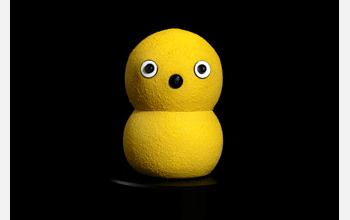Multimedia Gallery
Humanoid Robot Keepon
Keepon, a robot designed to interact with children for the purpose of studying social development and interpersonal coordination. Its minimal form is designed to make the robot's attentive, emotive and rhythmic behaviors easy to understand, even for children with developmental disorders such as autism. Keepon has four degrees of freedom, a soft skin for safety, lifelike movement cameras in its eyes and a microphone in its nose. Keepon was designed by Hideki Kozima, a professor at Miyagi University in Japan and co-founder of BeatBots LLC, home of Keepon.
More about this Image
BeatBots LLC develops robotic characters that defy entrenched notions of robots as impersonal, mechanical tools. The company's core design philosophy centers around cuteness, personality, simplicity and rhythmic interaction. BeatBots is based in Pittsburgh, Pa., in a growing nexus of innovative robotic technology and artistic activity.
The company was founded in 2007 by Marek Michalowski, a doctoral student in the Robotics Institute at Carnegie Mellon University, and Hideki Kozima, formerly a senior research scientist at Japan's National Institute of Information and Communications Technology (NICT) and currently a professor at Miyagi University. The two worked together on Keepon, and the robot was used for over five years in peer-reviewed research on social development and interpersonal coordination, as well as in therapeutic practice for children with developmental disorders such as autism.
Keepon has won numerous awards and prizes and been exhibited at several events. Papers about Keepon have been presented at international conferences and published in journals, and the robot has been the subject of several television news programs. To learn more, visit the Beatbots website Here. (Date of Image: October 2008)
Credit: ©BeatBots LLC; "Keepon" and "Beatbots" are trademarks of BeatBots LLC; http://beatbots.org
Images and other media in the National Science Foundation Multimedia Gallery are available for use in print and electronic material by NSF employees, members of the media, university staff, teachers and the general public. All media in the gallery are intended for personal, educational and nonprofit/non-commercial use only.
Images credited to the National Science Foundation, a federal agency, are in the public domain. The images were created by employees of the United States Government as part of their official duties or prepared by contractors as "works for hire" for NSF. You may freely use NSF-credited images and, at your discretion, credit NSF with a "Courtesy: National Science Foundation" notation.
Additional information about general usage can be found in Conditions.
Also Available:
Download the high-resolution JPG version of the image. (1.2 MB)
Use your mouse to right-click (Mac users may need to Ctrl-click) the link above and choose the option that will save the file or target to your computer.



